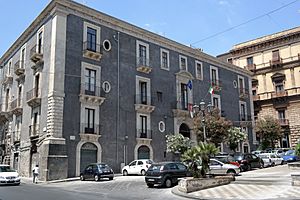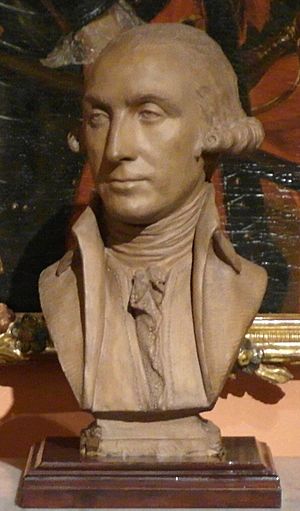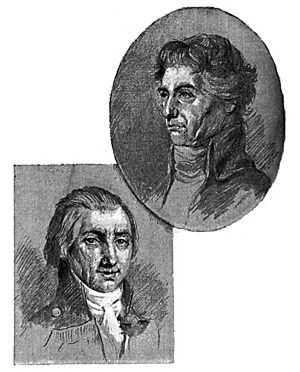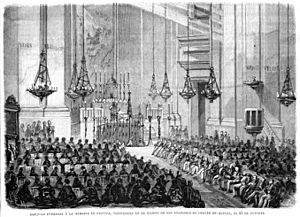Federico Gravina facts for kids
Quick facts for kids
Federico Gravina
|
|
|---|---|

Portrait at the Museo Naval de Madrid
|
|
| Birth name | Federico Carlo Gravina Cruyllas |
| Born | 12 August 1756 Palermo, Kingdom of Sicily |
| Died | 9 May 1806 (aged 49) Cádiz, Kingdom of Spain |
| Allegiance | |
| Service/ |
|
| Years of service | 1768–1806 |
| Rank | Admiral |
| Battles/wars | |
Federico Carlos Gravina y Nápoli (born 12 August 1756 – died 9 May 1806) was a brave and important admiral who served the Spanish Empire. He was from Sicily, an island in Italy. Gravina fought in major conflicts like the American Revolution and the Napoleonic Wars. Sadly, he died from serious injuries he got during the famous Battle of Trafalgar. An explorer named Jacinto Caamaño later honored him by naming Gravina Island in Alaska after him.
Federico Gravina was born in Palermo, the main city of the Kingdom of Sicily. He came from a very important noble family. Because of family traditions, Federico chose to join the military.

When he was just 12 years old, he joined the Spanish Navy as a naval cadet. This was a special school for future naval officers. His uncle, who was an ambassador, helped him get in. Federico quickly started his career. He served on a ship called Santa Clara in Brazil. During this trip, he even took command for the first time, getting a castle on a small island to surrender.
In 1777, he survived a dangerous boat accident where many others drowned. A year later, he returned to Spain and helped fight against pirates from Algeria. He then got his first command, a ship called San Luis. With this ship, he took part in the Great Siege of Gibraltar between 1779 and 1782. During this siege, he successfully captured a British ship called HMS St Fermin.

After showing great skill, he was promoted to commander. He then helped in an attack against Menorca, an island that was controlled by the British. He was especially brave during the attack on the fortress of San Felipe. Because of his actions, he was promoted again to captain. In 1785, he led a group of ships fighting against corsairs (pirates) from Algeria.
In 1788, he traveled to Istanbul (then called Constantinople) to take an ambassador back home. While there, he made important notes about the stars. After King Charles III of Spain died, Gravina quickly sailed to the Spanish colonies to share the news. His ship, the Paz, made one of the fastest journeys ever from Cadiz to Central America.
In 1790, he was given command of a large warship, the Paula. He helped in the evacuation of Oran. That same year, he showed he was also good at organizing. During a disagreement with Britain over Nootka Sound, Gravina helped create a huge Spanish fleet. This was the biggest Spanish fleet in 200 years! Luckily, the problem was solved without a war.
In 1793, Gravina became the second-in-command of the Spanish fleet. He worked with British Admiral Hood during the Siege of Toulon in France. During this time, Spain and Britain were allies. Gravina even visited Portsmouth in England to learn about British naval methods. When he returned to Spain, he led a group of four ships in the Mediterranean Sea, fighting against Revolutionary France. His main ship was the Hermenegildo.
In 1796, Spain made peace with France and later joined the war against Britain. Gravina served under Admiral Jose de Mazarredo. In 1801, he was sent to Santo Domingo (now Haiti) in the West Indies. He commanded the Spanish fleet during a French expedition there.
In 1804, he became the Spanish Ambassador to France in Paris. He agreed to this job only if he could return to the navy if war broke out. While in Paris, he attended Napoleon's coronation as Emperor. He also became good friends with Denis Decres, the French naval minister. Gravina played a big part in making a deal between France and Spain. This deal meant the Spanish Navy would help Napoleon. Because of his great service, King Charles IV made him the Commander-in-Chief of the Spanish Navy. Gravina returned to Cadiz in February 1805.
The Battle of Trafalgar

When Napoleon planned to invade Great Britain, Gravina followed orders from the Spanish government. He was placed under the command of French Admiral Pierre-Charles Villeneuve. Their plan was to sail the combined French and Spanish fleet into the Caribbean Sea. This was meant to trick the British fleet and draw them away. The main goal was to allow 180,000 French soldiers to cross the English Channel.
However, the plan did not work. On their way back, the French and Spanish fleet was met by a British fleet led by Sir Robert Calder at the Battle of Cape Finisterre. The Spanish ships Firme and San Rafael were lost. After this battle, the fleet went to Cádiz for safety, which was against Napoleon's original plan. The French soldiers never got on their ships and were moved to other parts of Europe.
In Cadiz, the Spanish and French commanders did not get along well. Gravina and other Spanish leaders strongly disagreed with the French. The French wanted to sail immediately, but the Spanish advised waiting for better weather. Gravina was also worried about a yellow fever outbreak that had made many of his sailors sick. There was also a lot of anger towards the French because the Spanish felt they hadn't been supported enough at the Battle of Cape Finisterre.
The fleet finally left Cadiz on October 20, 1805. This led to the famous Battle of Trafalgar the very next day.
During the battle, Gravina was on his main ship, the Príncipe de Asturias. His ship was attacked by three British ships at the same time. The main mast and another mast were broken, and the ropes and sails were torn to pieces. Around 3:30 in the afternoon, Gravina's left arm was badly injured by grapeshot, a type of cannon ammunition. Seeing that they were losing, he managed to gather ten ships around his flagship and returned to Cadiz, being towed by another ship.
Even though he was badly wounded, Gravina was promoted to the highest military rank: Capitán-General de la Armada (Admiral of the Fleet). But he never fully recovered from his injuries. He sadly passed away on May 9, 1806, at the age of 49.
Before he died, he said, "I am a dying man, but I die happy; I am going, I hope and trust, to join Nelson, the greatest hero that the world perhaps has produced." This shows his respect for the British admiral he fought against.
The Gibraltar Chronicle, a newspaper, also praised him, saying, "Spain loses in Gravina the most distinguished officer in her navy; one under whose command her fleets, though sometimes beaten, always fought in such a manner as to merit the encomiums of their conquerors." This means even his enemies respected his fighting spirit.
Napoleon himself wrote in a letter on August 11, 1805: "Gravina is all genius and decision in combat. If Villeneuve had had those qualities, the battle of Finisterre would have been a complete victory."
Gravina is buried at the Panteón de Marinos Ilustres (Pantheon of Illustrious Sailors) in San Fernando, Cadiz.
See also
 In Spanish: Federico Gravina para niños
In Spanish: Federico Gravina para niños


